She was the 22-year-old intern who was vilified after her affair with Bill Clinton almost wrecked his presidency. In light of the #MeToo movement, can a new TV drama rescue Monica Lewinsky’s reputation? Former US correspondent Martin Fletcher, who witnessed the scandal first-hand, reports.
Twenty-five years ago, Bill Clinton was re-elected as President of the United States, defeating Bob Dole in a landslide. He had survived the missteps and controversies of his first term and the loss of Congress to the Republicans in 1994.
The economy was strong. America was at peace.
Clinton, a man of prodigious energy, intellect and ambition, seemed well placed to become one of the more consequential US presidents. Except that he was also a man of prodigious appetites – for sex as well as food.
Like other journalists based in Washington DC at that time, I was well aware of Clinton’s past womanising. His 1992 presidential campaign had been rocked when Gennifer Flowers, a cabaret singer, claimed to have had a long affair with him when he was governor of Arkansas. In 1993,
Arkansas state troopers said they had procured women for him during his governorship. He had himself admitted “causing pain in my marriage”. His wife Hillary once described him as “a hard dog to keep on the porch”.
What none of us suspected was that the 49-year-old president had been conducting a reckless affair inside the White House with a 22-year-old intern just out of college and not much older than his daughter Chelsea.
When the Monica Lewinsky scandal finally erupted 14 months after Clinton’s re-election, his presidency was very nearly destroyed and the course of US politics was changed forever.
The scandal dominated Clinton’s second term.
It contributed to Vice President Al Gore’s wafer-thin defeat by George W. Bush in the presidential election of 2000, and thus to Bush’s disastrous military interventions in Afghanistan and Iraq.
It fuelled the bitter partisan warfare that has since crippled America, and almost certainly played a role in Hillary Clinton’s narrow defeat by Donald Trump in 2016.
Beyond all that, the Monica Lewisky affair raised moral and cultural issues that reverberate with even greater force today – issues that will inevitably be revisited by Impeachment: American Crime Story, a 10-part dramatisation of the whole squalid saga of adultery, betrayal and political conspiracy (currently airing on SoHo and Sky Go).
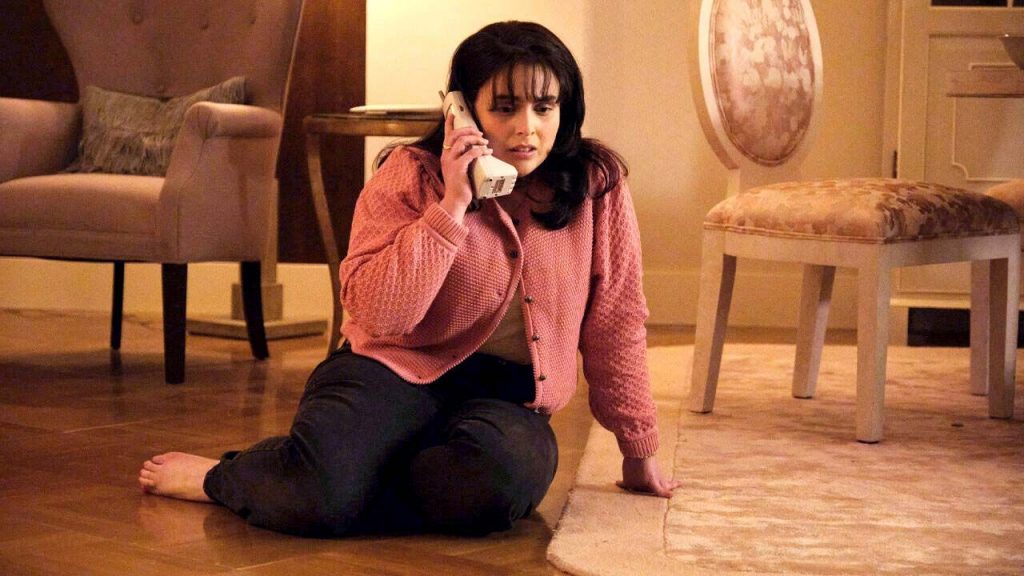
At the time, Clinton and Monica both insisted their affair was consensual, and Hillary not only stood by her husband, but appeared complicit in a surreptitious White House campaign to portray Monica as a star-struck bimbo who had set out to seduce the president.
A quarter of a century on, with the rise of the #MeToo movement and the Harvey Weinstein, Jeffery Epstein and Prince Andrew scandals, Clinton’s conduct looks much more like that of an unscrupulous and powerful older man exploiting an infatuated junior employee for his own sexual gratification.
Monica’s own views have changed as well. Writing in Vanity Fair in 2014, she said: “Sure, my boss took advantage of me, but I will always remain firm on this point: it was a consensual relationship. Any ‘abuse’ came in the aftermath, when I was made a scapegoat in order to protect his powerful position.”
Four years later, in the same magazine, she wrote: “I now see how problematic it was that the two of us even got to a place where there was a question of consent. Indeed the road that led us there was littered with inappropriate use of authority, station and privilege. Now, at 44, I’m beginning to consider the implications of the power differentials that were so vast between a president and a White House intern. I’m beginning to entertain the notion that, in such a circumstance, the idea of consent might well be rendered moot.”
In December 1998, Clinton became only the second president in US history to be impeached, but he was acquitted of charges arising from the scandal after a 21-day trial in the US Senate.
Impeachment, which Monica helped produce, amounts to a fresh trial of America’s 42nd president, but this time with dramatically different standards of what is and is not acceptable conduct.
I vividly remember the Democrats’ euphoria when Clinton – young, personable and progressive – defeated the first President Bush in 1992. After 12 years of Bush and Ronald Reagan, the Democrats owned the White House again. A million people descended on Washington DC for his inauguration. Michael Jackson, Aretha Franklin, Bob Dylan, Diana Ross and other stars performed during a joyful two-day celebration of the new “Camelot”.
Many Republicans, by contrast, were unable to accept as their president a man who had slept around, evaded the Vietnam War draft, lied and smoked pot. Their hatred of “Slick Willie” only increased as he proceeded to relax a ban on gays in the military, ease abortion restrictions and put his robustly feminist wife in charge of healthcare reform.
Then, six months after Clinton took office, his Arkansas chum and deputy White House counsel Vince Foster took his own life. His death revived interest in a dubious Arkansas land deal known as Whitewater that the Clintons had entered into 15 years earlier. In 1994, under intense pressure, Clinton finally agreed that a special prosecutor should be appointed to investigate that deal.
It was a decision he would bitterly regret, because a special prosecutor has the right to follow a trail of possible wrongdoing – however far it takes him from the first alleged offence. Kenneth Starr, a committed Republican and zealous Christian, proceeded to do exactly that.
At about the same time, a woman named Paula Jones claimed Clinton had sexually harassed her – dropping his trousers and demanding oral sex – in an Arkansas hotel room in 1991, when he was state governor and she a junior state employee. With the clandestine encouragement of various hard-line conservatives, she sued Clinton for $750,000 and thus became embroiled in the Lewinsky scandal in a way she had never imagined.
Shortly after that, in November 1994, Newt Gingrich’s Republicans seized control of Congress for the first time in 40 years, and within a year, their confrontation with Clinton over the budget caused a government shutdown. Most of the White House staff had to be furloughed, leaving it dependent on unpaid interns.
One of those interns was Monica Lewinsky, an attractive and impetuous young woman from a well- to-do Californian family who got the job through a family friend. She worked for Leon Panetta, the White House Chief of Staff.
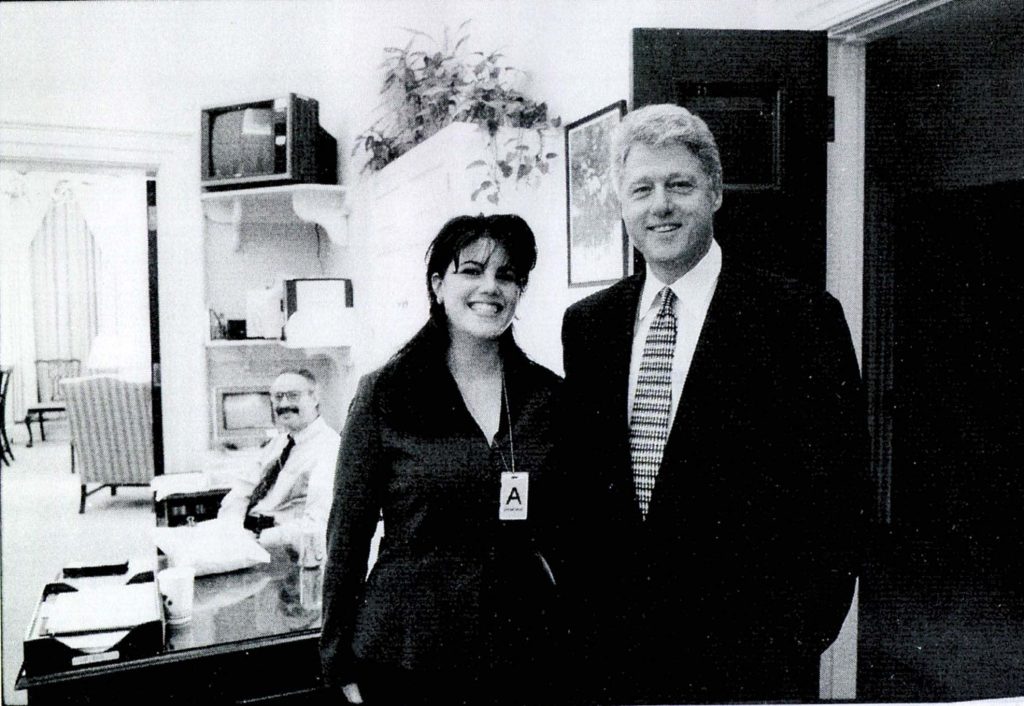
The first time Monica saw Clinton on the South Lawn, she was smitten. “He exudes sexual energy,” she told her biographer, Andrew Morton.
A few weeks later, he shook her hand during a ceremony and, she says, “we shared an intense but brief sexual exchange. He undressed me with his eyes.”
The following day, at a surprise birthday party thrown for Clinton by the White House staff, she blew him a kiss. He laughed.
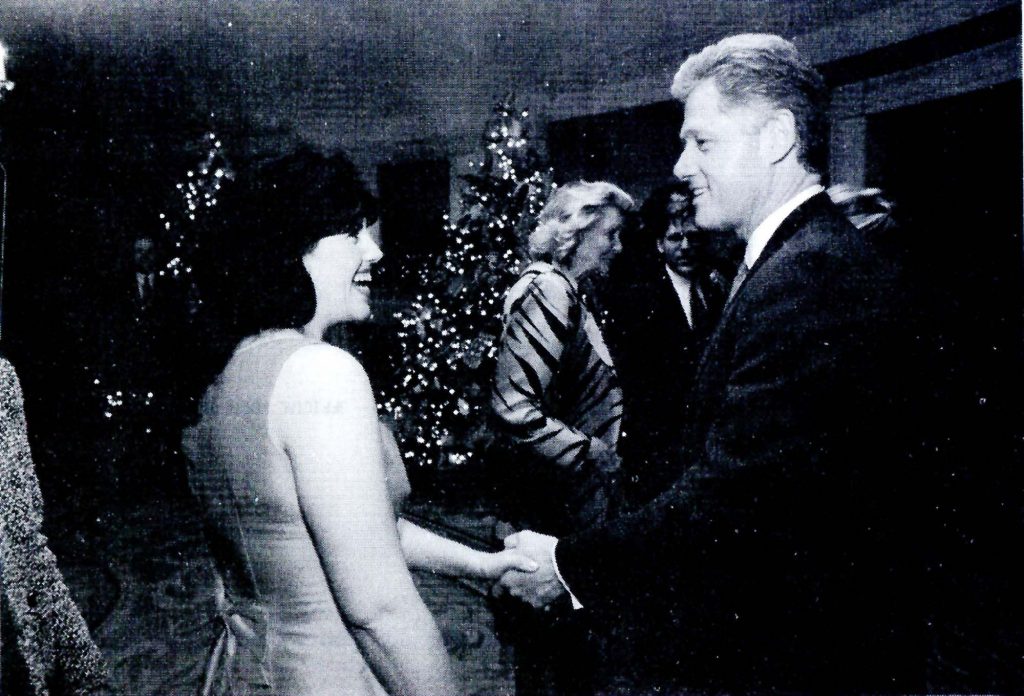
IMAGE VIA GETTY
She continued flirting with him until, on the first day of the shutdown in November 1995, Clinton came to Leon Panetta’s office and Monica discreetly lifted the back of her jacket to give him a glimpse of her G-string. Later that evening, he called her into an empty office in the largely deserted White House. “You know, I have a really big crush on you,” she blurted out. He kissed her, and she performed oral sex on him while he took a call from a congressman.
Two days later, she was working late. Clinton invited her into the Oval Office and they “fooled around” in his private bathroom. And so the affair progressed.
He would call her at home at night and have telephone sex. He would summon her at weekends or public holidays, when the White House was empty or Hillary was away. He gave her gifts. She bought him ties, which he wore in public as a signal to her. On March 31, 1996, she famously moistened a cigar in a sexually explicit manner during an Oval Office encounter.
They sought to be discreet, but Clinton’s aides grew suspicious, and that April, deputy chief of staff Evelyn Lieberman engineered Monica’s transfer to the Pentagon. “Why did they have to take you away from me?” Clinton asked as she wept. He promised to bring her back to the White House if he was re-elected that November.
He continued to call her, often for phone sex, but she hated not seeing him and disliked her new job. She was befriended by Linda Tripp, a prudish older woman who had also been transferred from the White House to the Pentagon. Unbeknown to Monica, Linda loathed the Clintons and what she regarded as their lax standards.
Following Clinton’s re-election, Monica told Linda about her affair with the president and continued to inform her about its on-again off-again progress. On February 28, 1997, the president invited Monica to watch him record his weekly radio address. Afterwards, in his private bathroom, she performed oral sex on him. His semen stained her blue dress.
Linda encouraged Monica’s pursuit of the president until, on May 24, he told the young woman their affair was over, saying he hated deceiving his wife and daughter. She called it D-Day, or Dump Day.
He added to her misery by failing to find her a White House job, although he did enlist Vernon Jordan, a businessman and close friend, to find her work in New York. At the behest of her friend Lucianne Goldberg, Linda had begun secretly recording her phone conversations with Monica.
By that time, Paula Jones’ lawsuit was live again, the Supreme Court having ruled that Clinton did not enjoy immunity as president. Linda contacted Paula’s lawyers, who were eager to establish a pattern of predatory behaviour by Clinton that would lend weight to their client’s claims. The lawyers duly subpoenaed both Linda and Monica, and thereafter events moved fast.
On January 7, 1998, Monica signed a sworn affidavit in which she declared: “I have never had a sexual relationship with the president.” She also urged Linda to say nothing. On January 12, however, Linda told Kenneth Starr about Clinton’s affair and her 22 hours of tape recordings.
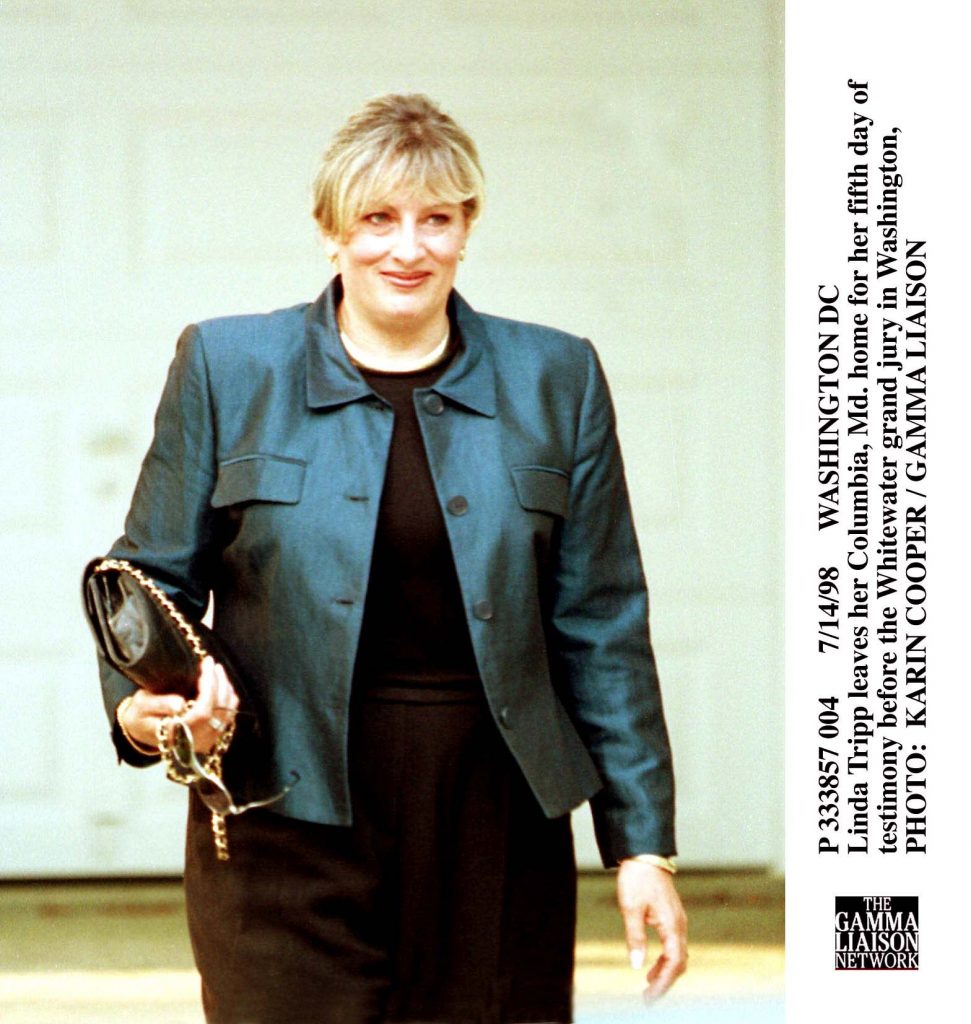
IMAGE VIA GETTY
On January 13, wearing a listening device at Starr’s request, Linda met Monica for lunch at the Ritz-Carlton in Pentagon City and got her to incriminate herself. On January 16, two FBI agents detained Monica as she met Linda for another lunch at the Ritz-Carlton, and took her to Room 1012 for what they called “prom night”.
This dramatic turn of events serves as the opening scene in Impeachment – actress Beanie Feldstein plays Monica, and is startled by Linda (a heavily made-up Sarah Paulson), who appears flanked by two federal agents. The penny dropping quickly and heavily, Monica calls her double-crossing colleague “that treacherous bitch”.
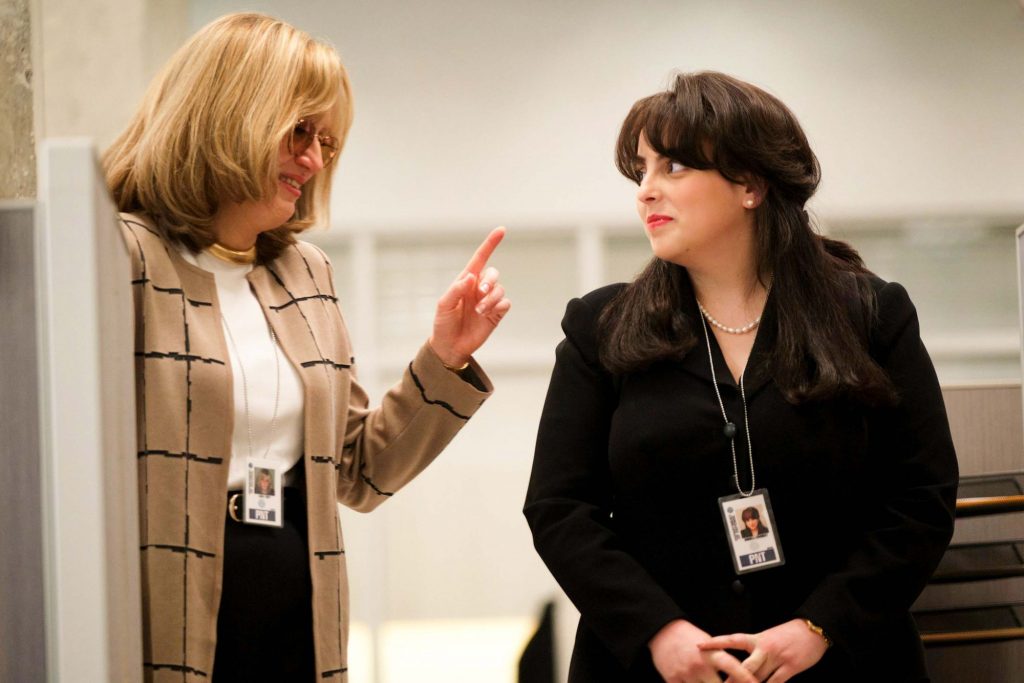
Monica was grilled, without a lawyer, for 11 hours by up to a dozen of Starr’s men. They told her, preposterously, that she faced 27 years in prison for perjury, obstructing justice and witness tampering unless she cooperated in a “sting” against the president. Monica, though terrified, refused.
“I’m not going to be the person to bring down the President of the United States,” she told them.
The following day, unaware of Linda’s treachery, Clinton – portrayed in the show by the British actor Clive Owen in heavy prosthetics – denied any “sexual relations” with Monica in a sworn deposition to Paula’s lawyers. Starr had trapped the president in an apparent lie, and his team began judiciously leaking.
On January 18, the Drudge Report cited rumours that Clinton had had an affair with an unnamed intern. Three days later, The Washington Post named Monica Lewinsky as the intern, and from that point on she was caught in what she later called “the eye of a political, legal and media maelstrom like we had never seen before”.
Instead of coming clean, Clinton stood beside his wife at a White House event and flatly denied having relations with “that woman”. Hillary denounced what she called a “vast right-wing conspiracy that has been conspiring against my husband since the day he announced for president”.
Clinton offered Monica no support as her flat in Washington’s Watergate complex was besieged by the media and searched by Starr’s agents. She was portrayed as a “stalker”, a “sex siren” and a “home wrecker”. She was reviled by Republicans for immorality, and by Democrats for endangering their president. She was mocked for her weight, style and dress sense. Her past life was raked over. A former boyfriend falsely accused her of stalking him. Her mother was subpoenaed to testify against her. She feared her phone and flat were bugged, and was unable to speak to friends or family in case they were subpoenaed. Her lawyer turned into a publicity junkie. She considered suicide to escape what she called a “living hell”.

IMAGE VIA GETTY
In July 1998, Monica finally agreed to cooperate with Starr to avoid prosecution. “I didn’t feel good about it. I felt like Hitler’s whore. I felt what Starr was doing was so wrong. They were trying to hurt people I loved,” she said.
She was debriefed over several days. She handed over the stained blue dress and all the gifts the president had given her. In testimony to a grand jury, she was forced to describe her 20-odd encounters with Clinton in minute and humiliating detail, then saw those details leaked to the press. She felt “emotionally raped”, she said.
Eleven days later, Clinton was himself forced to testify before the grand jury, albeit from the White House.
Having earlier given a blood sample whose DNA matched that of the semen on the dress, Clinton had little choice but to admit to sexual encounters with Monica. But he deployed semantic gymnastics to argue that he had not lied when he denied having “sexual relations” with her in his sworn deposition to Paula’s lawyers. He insisted that Monica had “sexual relations” with him by performing oral sex, but not the other way round. He denied ever contacting her “genitalia, anus, groin, breast, inner thigh or buttocks”.
That night, in a televised address, Clinton admitted to “a relationship with Ms Lewinsky that was not appropriate”, but denied telling anyone to lie and called for an end to “the pursuit of personal destruction and prying into private lives”.
The following day, he, Chelsea and Hillary (in dark glasses) staged a strained hand-in-hand walk across the South Lawn to a helicopter waiting to take them away to what must have been a very fraught holiday at Martha’s Vineyard. Hillary later admitted that she wanted to “wring Bill’s neck”.
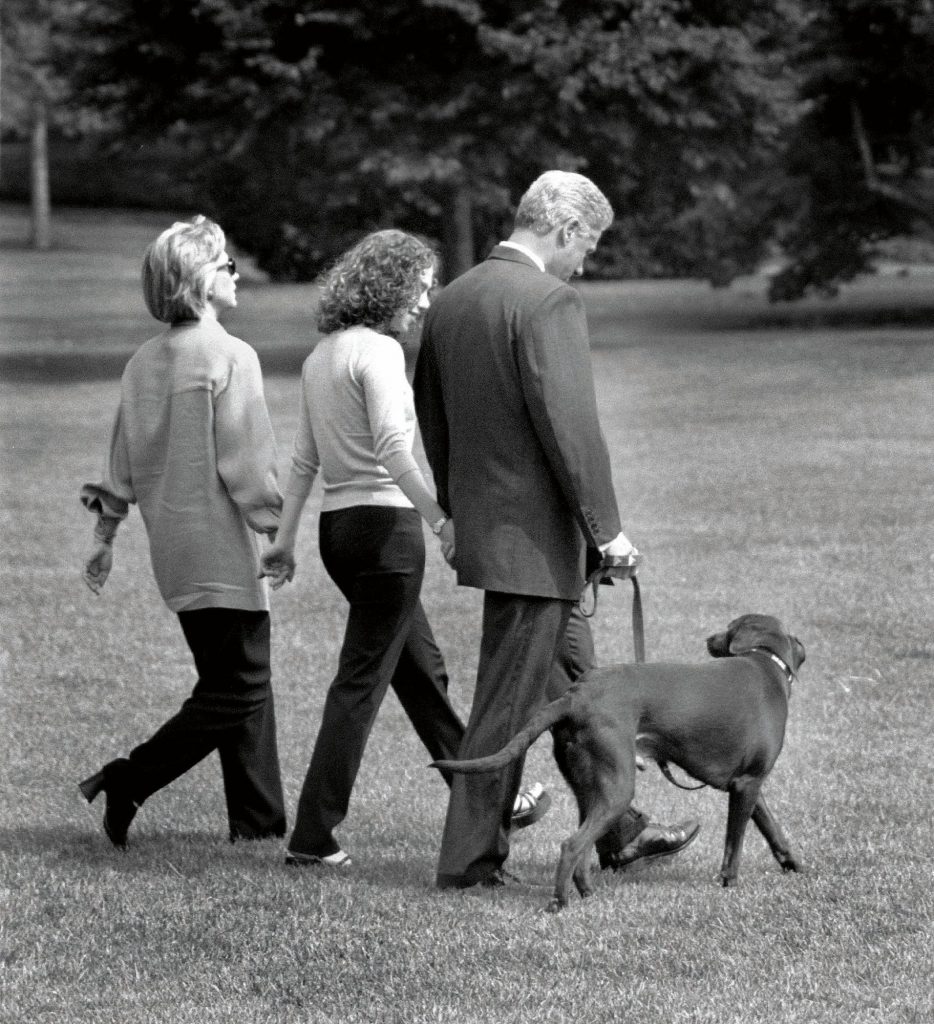
For several surreal weeks, Clinton’s presidency hung in the balance. On September 9, Starr sent a damning 445-page report, plus 18 boxes of evidence, to Congress. It cited 11 possible grounds for impeachment, including perjury, witness tampering, obstruction of justice and abuse of power. It spared no detail, mentioning “oral sex” 85 times and “breasts” 51 times. The Whitewater affair – the original subject of Starr’s four-year inquiry – got just four mentions.
Clinton expressed remorse. He told a White House prayer breakfast, “I don’t think there’s a fancy way to say that I have sinned.”
He belatedly apologised to Monica and her family. He also accused Starr of sexual McCarthyism and political skulduggery, effectively forcing the public to take sides.
The two-pronged strategy worked. Starr’s report was widely seen as salacious. It had the perverse effect of boosting Clinton’s poll ratings. Comedian Jay Leno joked that the president was planning his next sex scandal.
Many Democrats were disgusted by Clinton’s conduct, but considered him the target of a right-wing witch-hunt. Many women deplored his affair but strongly approved of his progressive political agenda. Feminists divided between those who backed a woman’s right to be sexually proactive and those who prioritised a woman’s right to be protected from sexual predation.
In their hubris, Gingrich’s Republicans misjudged the public mood. Eager to please the Christian right ahead of that November’s congressional elections, they chose to press for impeachment rather than merely censure Clinton. But on election day they actually lost five House seats. The Senate then voted, largely on party lines, to acquit the president on the two charges of lying under oath and obstructing justice.
Clinton had survived – just – but the early hopes and idealism of his presidency were shot.
Monica has called those bizarre events of 25 years ago “a shambolic morass of a scandal that dragged on for 13 months, and many politicians and citizens became collateral damage – along with the nation’s capacity for mercy, measure and perspective”.
It was certainly a story without heroes, saints or winners; just adulterers, zealots, traitors, hypocrites and victims. As one of the makers of Impeachment noted, the title applies to most of the protagonists – not just Clinton.
Gingrich resigned as house speaker after the 1998 congressional elections. He later admitted that he had been cheating on his wife even as he had led the impeachment proceedings against Clinton.
Starr came to be seen as a puritanical, partisan prosecutor who strayed far beyond his remit in his determination to destroy Clinton. He joined Trump’s legal team during his first impeachment trial in 2020.
Linda, who duped, manipulated and betrayed Monica, left Washington to run a year-round Christmas decorations store in rural Virginia. She died in April last year after acknowledging that she was the “villain from central casting”, but still protesting that she acted through patriotism and a desire to protect Monica from a predatory president.
“What it was was a series of encounters to address a physical need, a use of a young girl, and then the sort of cold, hard dismissal of her on any human level,” she told the Slow Burn podcast.
Hillary, boosted by a wave of public sympathy following her husband’s infidelity, went on to become a US senator and secretary of state before narrowly losing the 2016 presidential election to Trump. By then, her past support for her husband and her complicity in his disparagement of the women involved (she once called Monica a “narcissistic loony toon”) had become a liability. It undermined her support among women and her ability to attack Trump for his own serial abuse of women. Curiously, though, Monica voted for her.
Bill Clinton was never charged over the Whitewater affair. He agreed to a $1.2 million out-of-court settlement with Paula Jones. But he was irredeemably tarnished. He admitted in his autobiography that his affair was “immoral and foolish”. On top of that, he failed to protect Monica when the scandal broke and has not spoken to her since.
With the rise of the #MeToo movement, he has kept an increasingly low profile. He “has been largely sidelined amid new scrutiny of his past misconduct with women”, The New York Times reported during the 2018 congressional elections.
Perversely, the one person who has emerged with some credit from the scandal is the young woman who was caught in the middle of Starr’s vendetta: Monica herself. She conducted herself with a degree of dignity and grace as she was publicly mocked, reviled, humiliated and abandoned. She admitted her “colossal mistake”, voiced regret and refused to portray herself as a victim.
She admitted her “colossal mistake”, voiced regret and refused to portray herself as a victim
In the scandal’s aftermath, Monica had to be treated for post-traumatic stress disorder. Faced with enormous legal bills, she started a handbag business, advertised a dietary programme and appeared briefly on a dating reality show – but was accused of cashing in on her notoriety.
In 2005, she moved to London to “lay low” and study social psychology at the London School of Economics. She struggled to find employment because of her past, but has re-emerged in recent years as a campaigner against cyberbullying. She receives standing ovations at public appearances. She speaks well – and wittily. “I’m the only person over 40 who doesn’t want to be 22 again,” she quipped during a TED Talk.
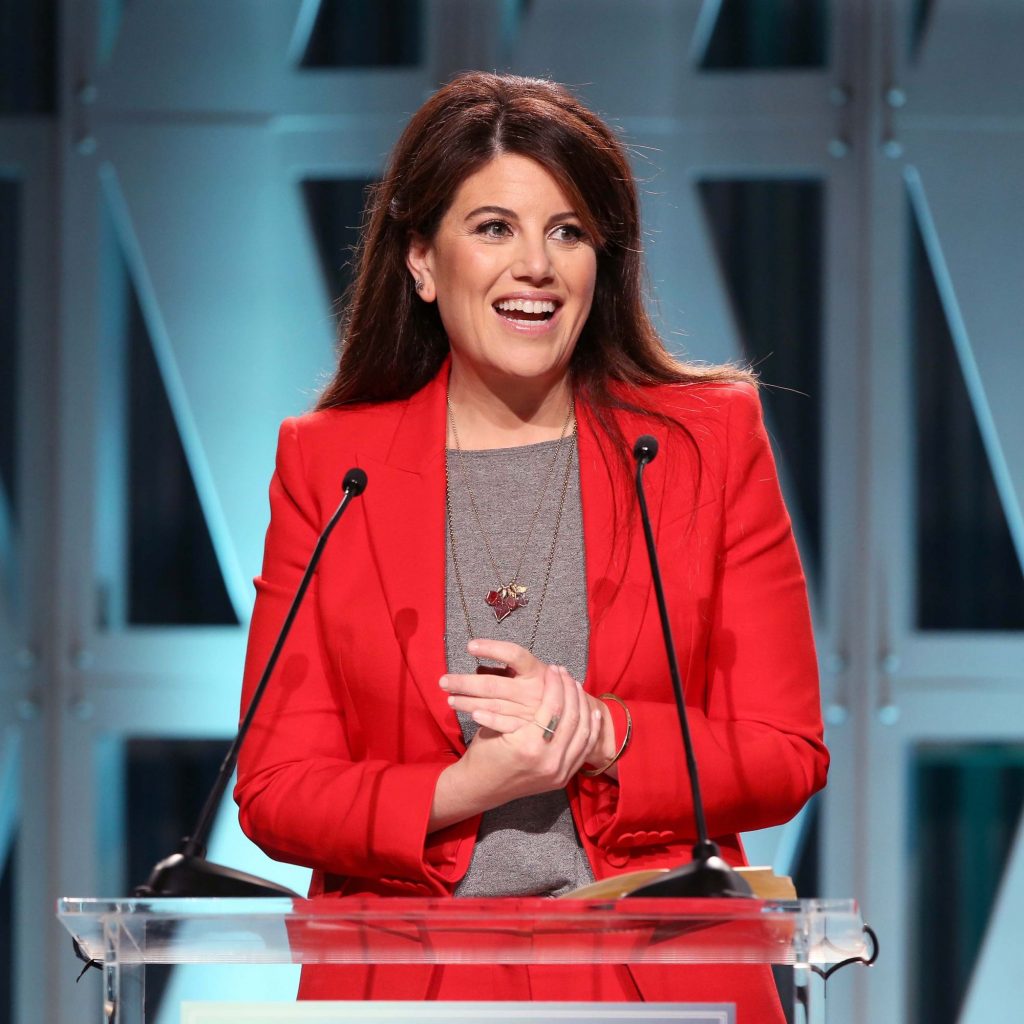
Now, finally, it is she who is empowered and she who has a voice. She advised on every scene of Impeachment. The narrative will be hers – not Starr’s, Clinton’s or the media’s – and the show’s star, Beanie Feldstein, says she hopes it will “redeem” Monica.

As Monica, now 48, told The New York Times recently, “The reality is that this story has been part of a collective conversation for 20 years and, as I evolve, as the world evolves, it comes to have different meanings.”








